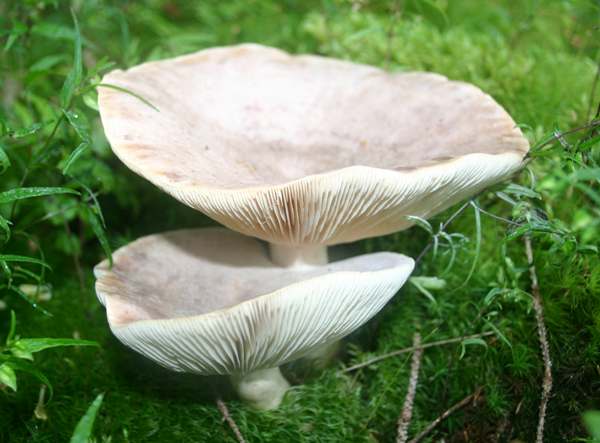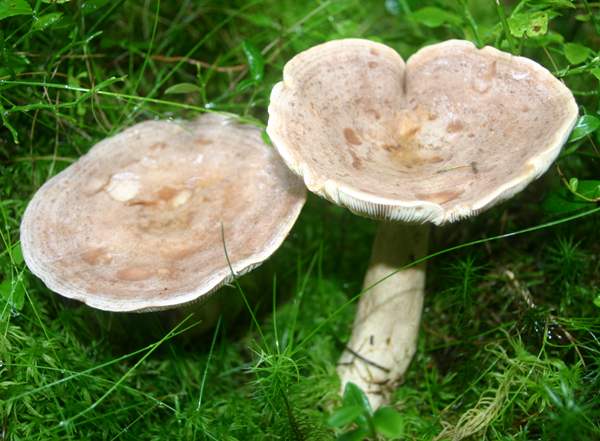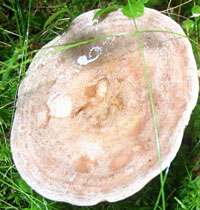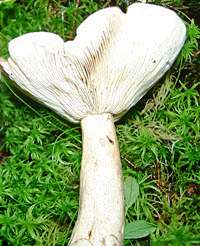Lactarius glyciosmus (Fr.) Fr. - Coconut Milkcap
Phylum: Basidiomycota - Class: Agaricomycetes - Order: Russulales - Family: Russulaceae
Distribution - Taxonomic History - Etymology - Identification - Culinary Notes - Reference Sources

The Coconut Milkcap, Lactarius glyciosmus, is known to be an ectomycorrhzal associate of birch trees (Betula spp.). This woodland mushroom might also form mycorrhizae with alders (Alnus spp.) and other kind of broadleaf deciduous trees.
This milkcap is drab and undistinguished, as are so many other mushrooms in this difficult genus, and so the habitat and its unusual odour are key field characters that should be noted if you want to fine down the identification options.

Distribution
Widespread and fairly common in broadleaf woodlands, nearly always with birch, throughout Britain and Ireland, this milkcap is also found in many parts of northern and central Europe. This species is also recorded in North America.
Taxonomic history
This mushroom was described in 1818 by the great Swedish mycologist Elias Magnus Fries, who gave it the binomial scientific name Agaricus glyciosmus. It was Fries himself who, in 1838, transferred this species to the genus Lactarius, thus establishing its currently-accepted common name Lactarius glyciosmus.
Synonyms of Lactarius glyciosmus include Lactarius impolitus, Agaricus glyciosmus Fr., Galorrheus glyciosmus (Fr.) P.Kumm., and Lactifluus glyciosmus (Fr.) Kuntze.
Etymology
The generic name Lactarius is Latin and means producing milk (lactating) - a reference to the milky latex that is exuded from the gills of milkcap fungi when they are cut or torn. The specific epithet glyciosmus also comes from Ancient Greek words glukos meaning sugar (or sugary), and osmos meaning smell. Sweet smelling is a suitable translation, as many people consider the smell of coconut to be sweet.
Identification guide
 |
CapColour varying between greyish lilac and dull buff; thin-fleshed; convex, flattening initially with an incurved margin, then developing a broad shallow depression, sometimes with a small central pimple; 2 to 5.5cm across. Cap flesh is pale buff rather than white. |
 |
GillsPale yellow, sometimes with a pinkish tinge, becoming lilaceous grey with age; decurrent, crowded; releasing white latex when damaged. StemColour as cap but paler; 2.5 to 6.5cm tall and 4 to 12mm diameter; cylindrical or slightly clavate and tapering towards apex; fragile; often hollow when old. |
SporesBroadly ellipsoidal, 7-8 x 5.5-6µm; ornamented with warts connected by a well developed network of ridges. Spore printCreamy-white. |
|
Odour/taste |
Odour of coconut; taste mild, becoming slightly hot and bitter after a while. |
Habitat & Ecological role |
Mycorrhizal, under broadleaf deciduous trees, nearly always birch. |
Season |
August to November in Britain and Ireland. |
Similar species |
No other pale milkcaps have such a distinctive coconut scent. |
Culinary Notes
The Coconut Milkcap is generally considered edible, but at least in Britain and Ireland this mushroom usually occurs in such small numbers that many fungi foragers leave it in preference for more abundant species.
Reference Sources
Fascinated by Fungi, 2nd Edition, Pat O'Reilly 2016, reprinted by Coch-y-bonddu Books in 2022.
Funga Nordica, Henning Knudsen and Jan Vesterholt, 2008.
Fungi of Switzerland, volume 6: Russulaceae, Kränzlin, F.
BMS List of English Names for Fungi.
Dictionary of the Fungi; Paul M. Kirk, Paul F. Cannon, David W. Minter and J. A. Stalpers; CABI, 2008
Taxonomic history and synonym information on these pages is drawn from many sources but in particular from the British Mycological Society's GB Checklist of Fungi.
Fascinated by Fungi. Back by popular demand, Pat O'Reilly's best-selling 450-page hardback book is available now. The latest second edition was republished with a sparkling new cover design in September 2022 by Coch-y-Bonddu Books. Full details and copies are available from the publisher's online bookshop...

